
Posted on 04/10/2015 4:15:39 AM PDT by Homer_J_Simpson

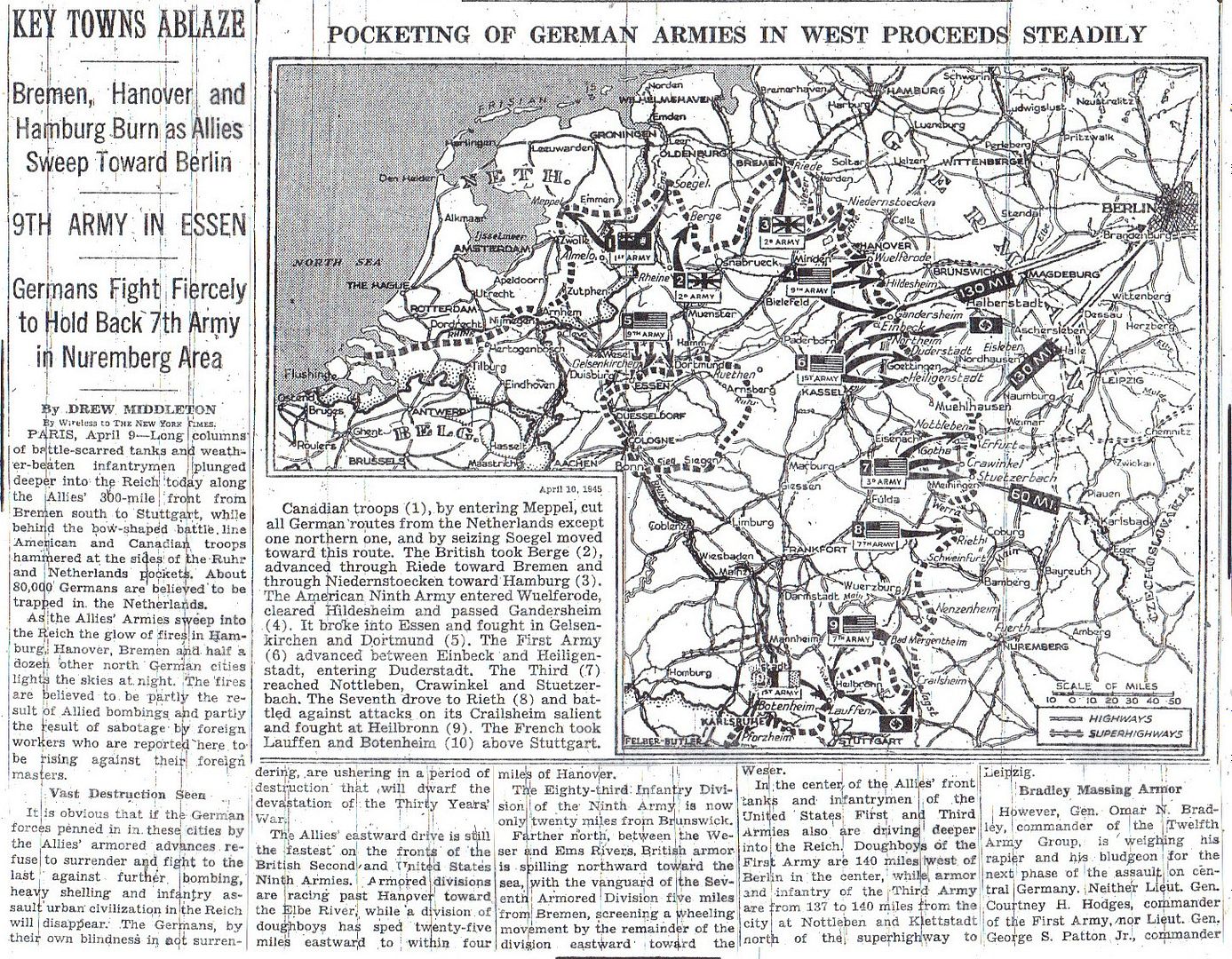

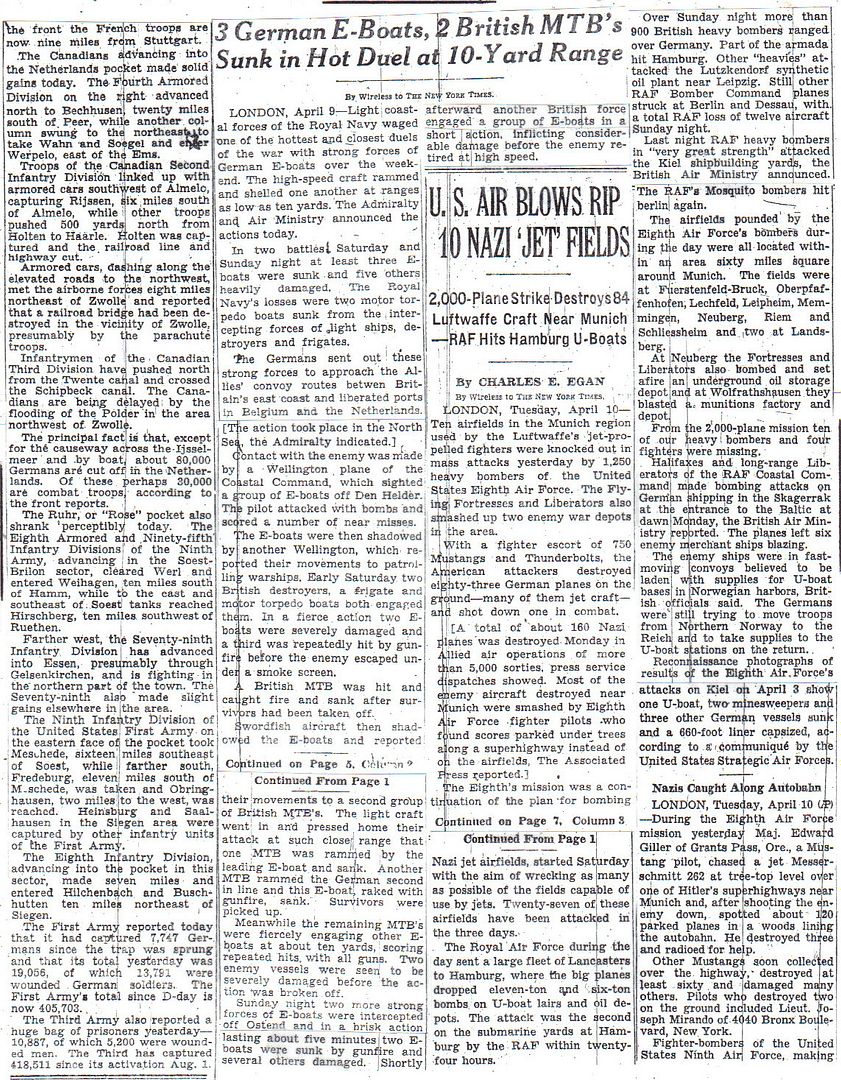
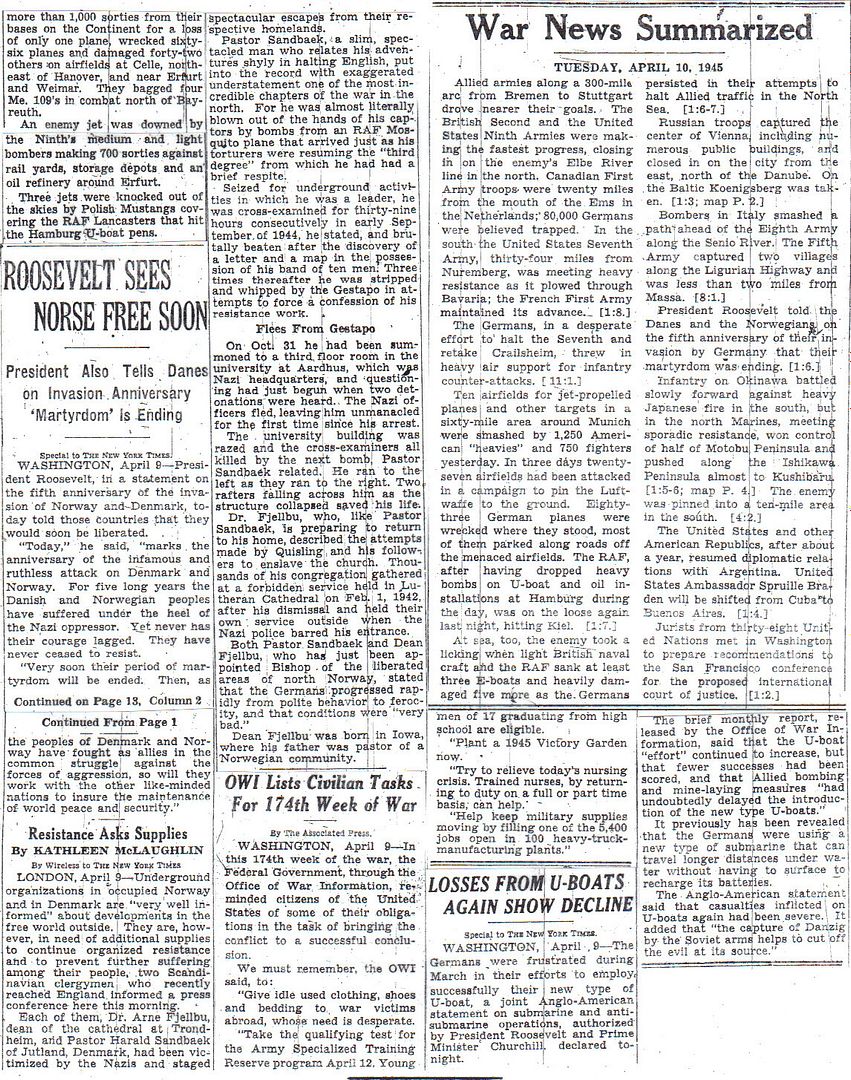

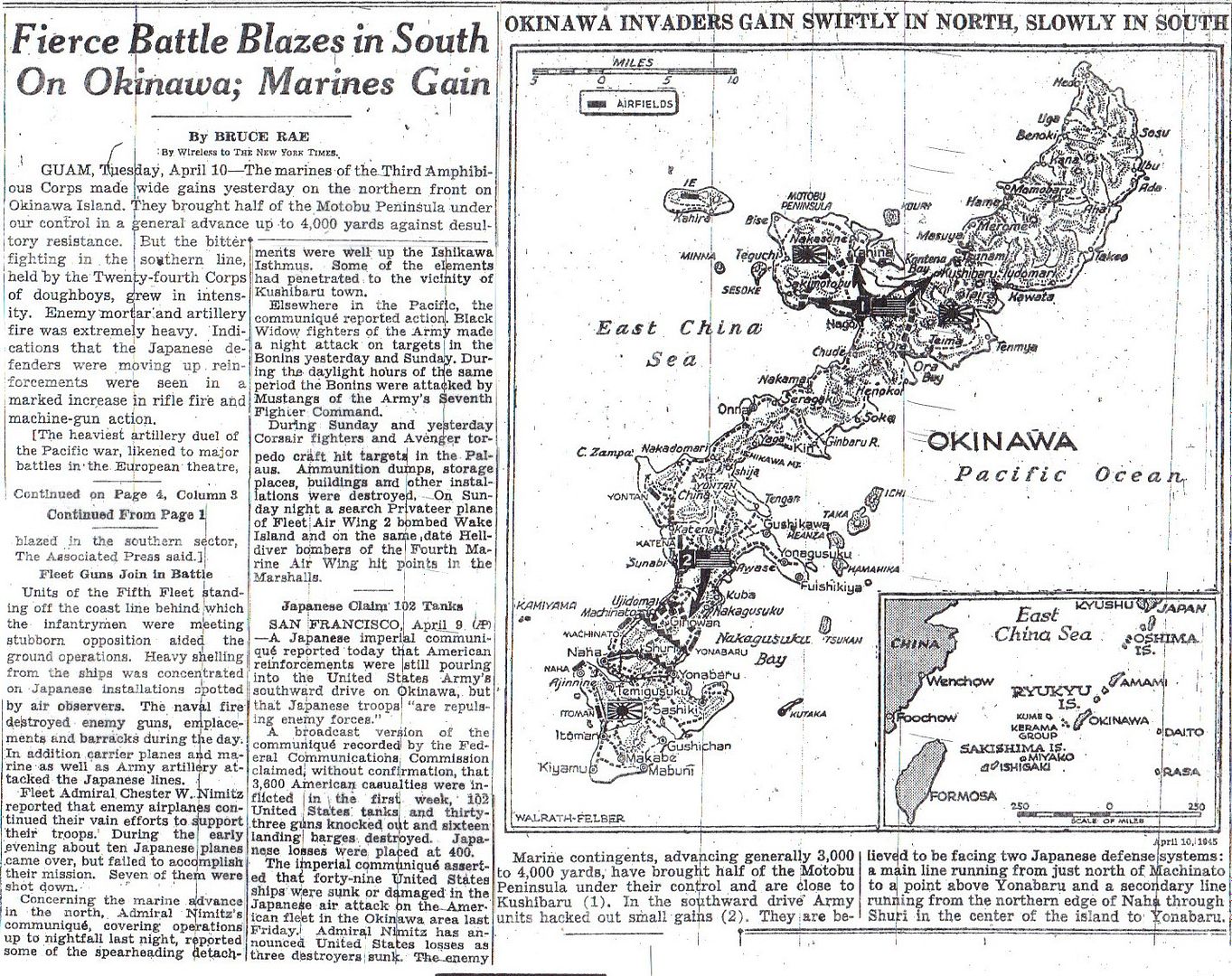

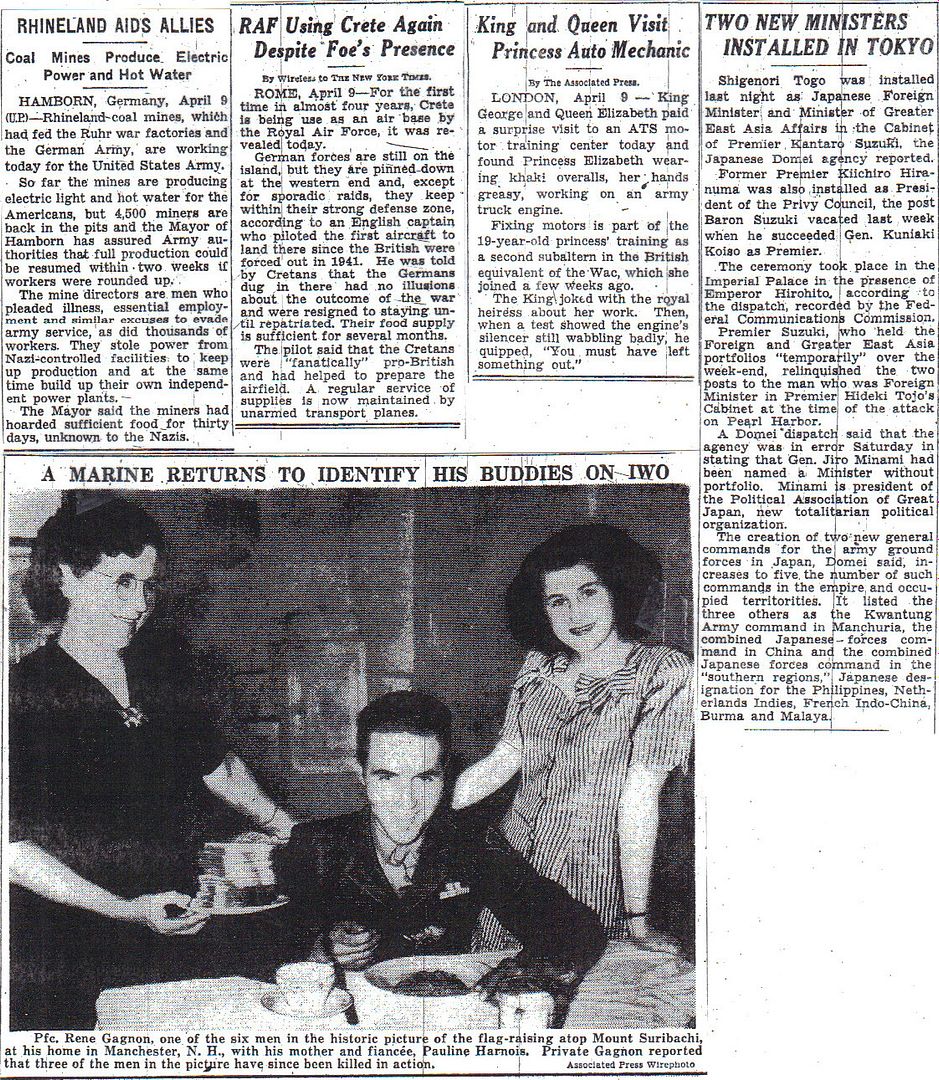
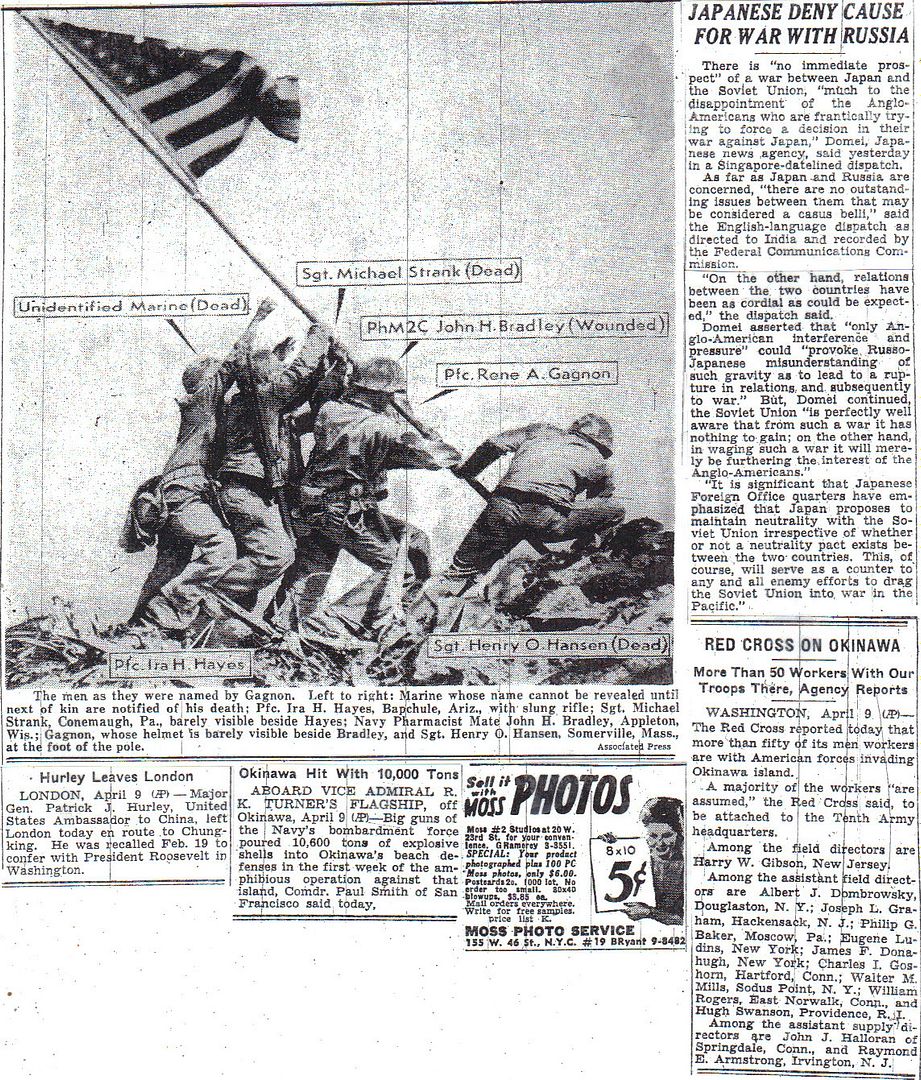

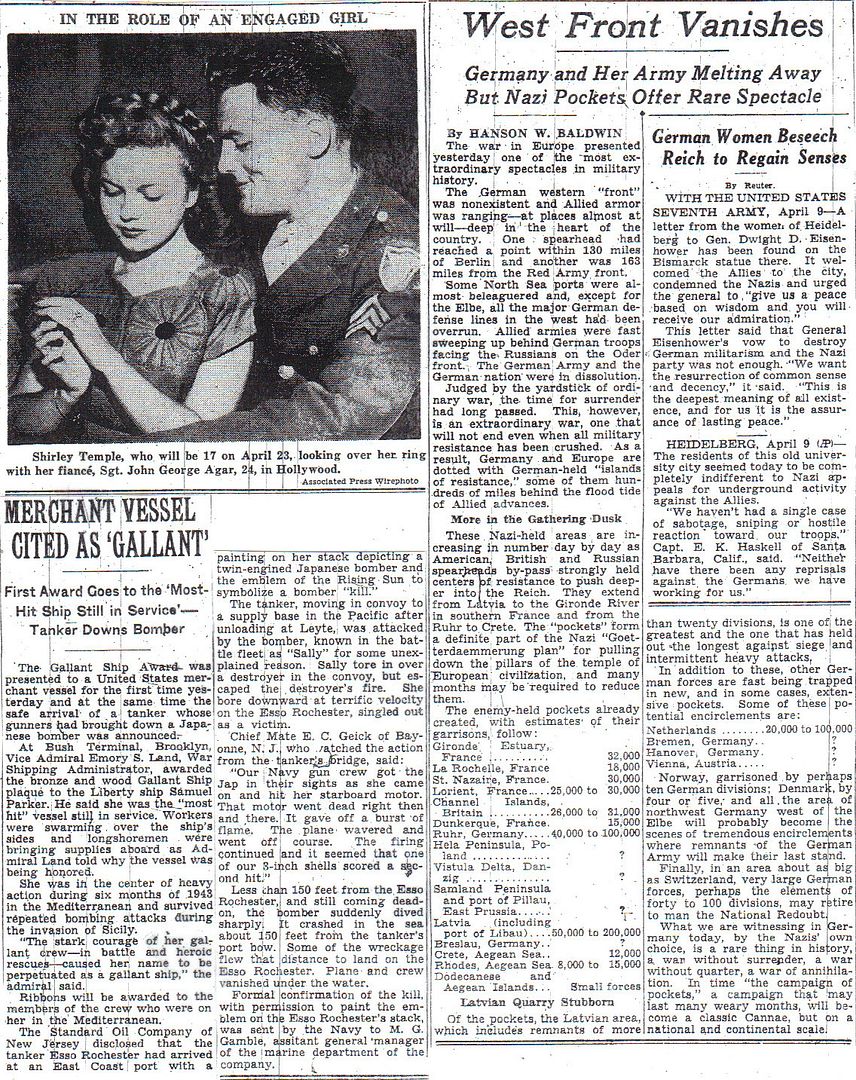
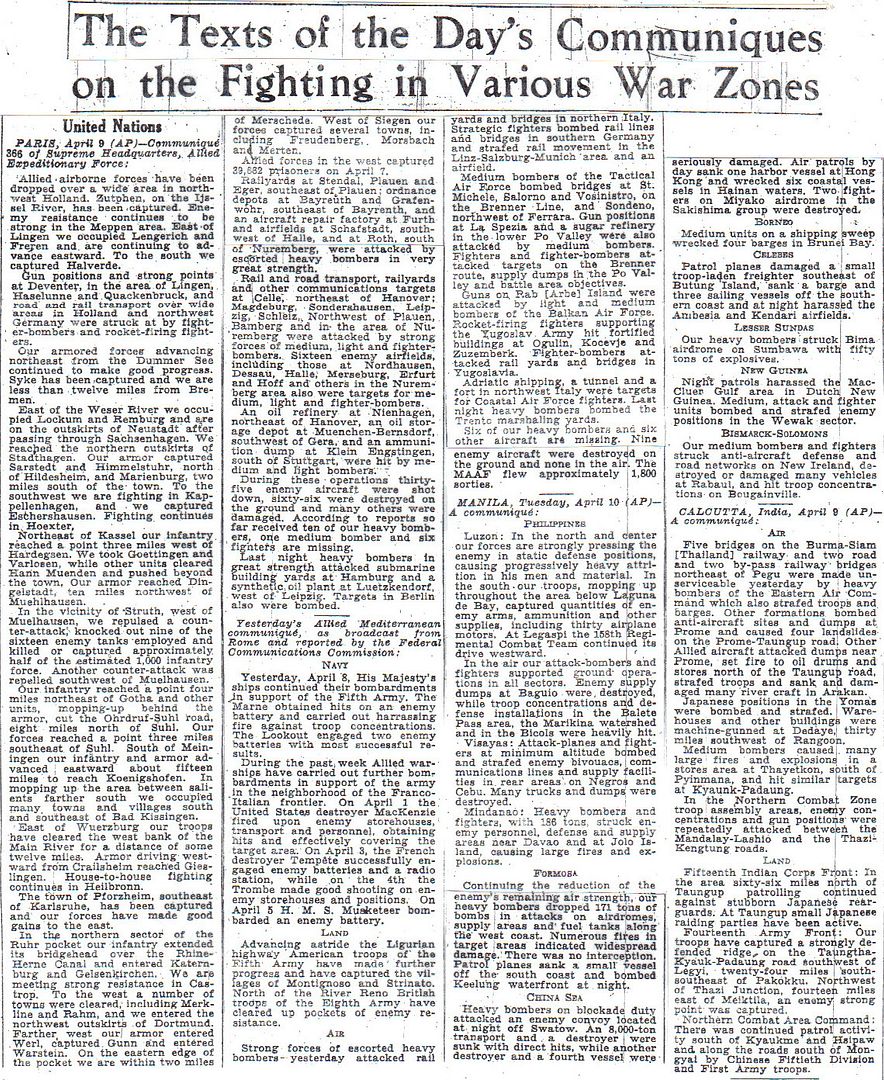
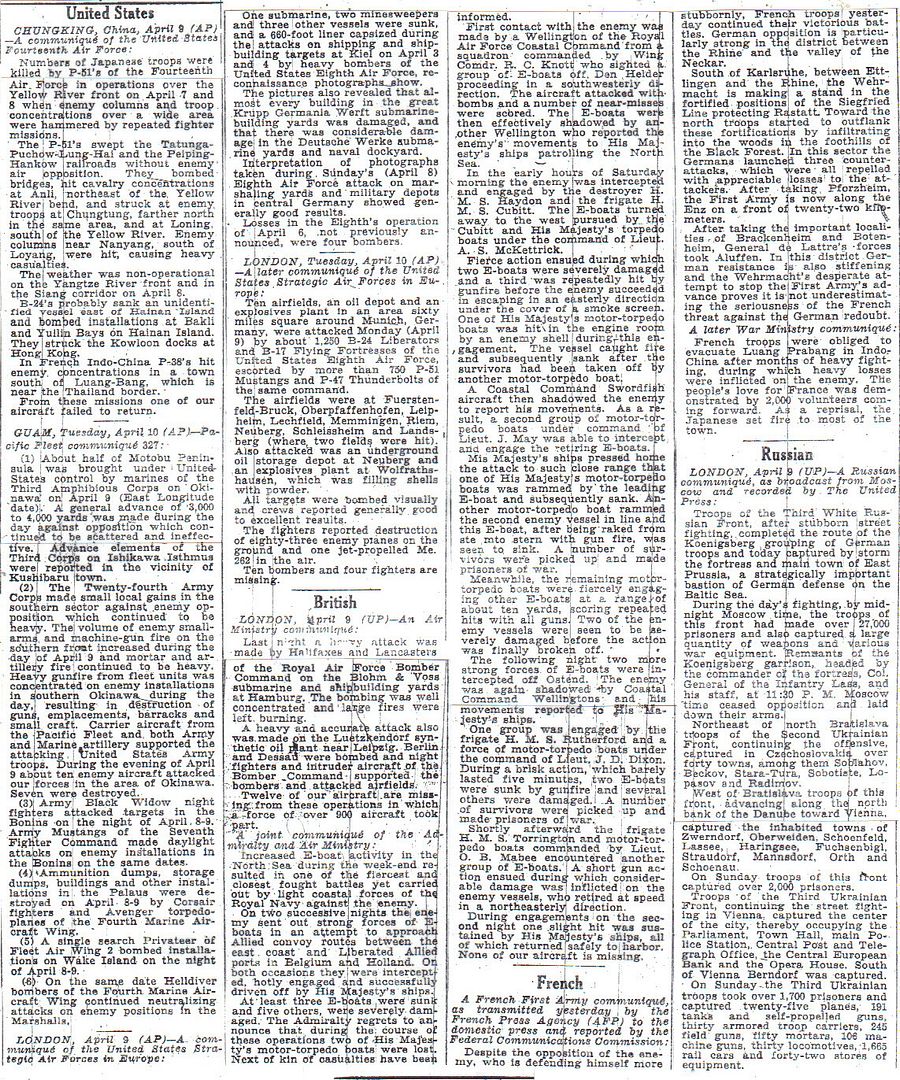
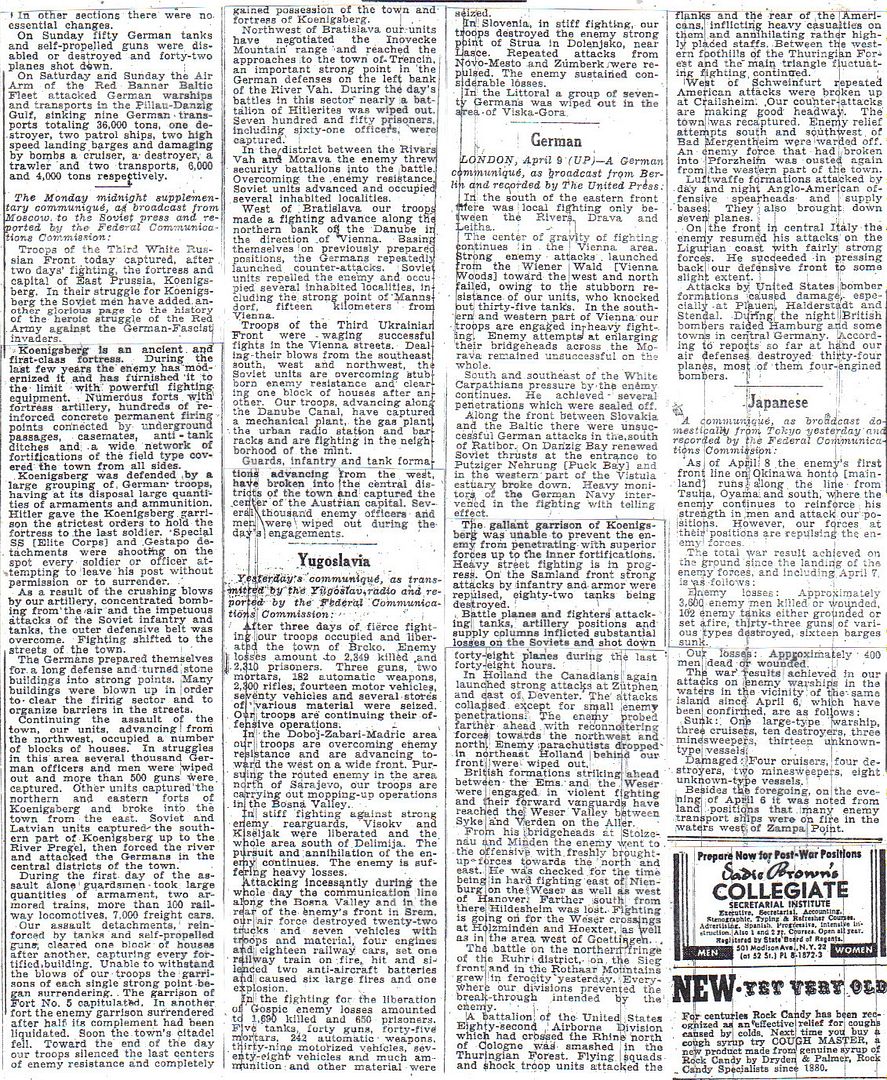
http://www.etherit.co.uk/month/3/10.htm
April 10th, 1945 (MONDAY)
GERMANY: Private John M. Galione, US 104th ‘Timberwolf’ Infantry Division, discovers the entrance to Mittelbau Dora, a huge Nazi concentration camp and manufacturing plant, after a 5 day scouting mission. More... (Mary Galione-Nahas)
The Eighth Air Force flies Mission 938: 1,315 bombers and 905 fighters are dispatched to attack airfields known or suspected to be used by jet aircraft; about 60 jets and a few conventional fighters attack the formations; 19 bombers and 8 fighters are lost; the AAF claims 328-4-249 Luftwaffe aircraft. They are attacked by surface to air missiles. More...
- 278 B-17s bomb the Army HQ munitions depot and another 139 bomb the airfield at Oranienburg; 11 hit Rechlin Airfield, the secondary; they claim 7-1-8 aircraft; 9 B-17s are lost. Escorting are 273 P-51s; they claim 11.5-0-8 aircraft in the air and 56-0-32 on the ground; 4 P-51s are lost.
- 132 B-17s hit Neuruppin Airfield; 9 others hit the marshalling yard at Stendal, the secondary; 1 B-17 is lost . The escort of 112 P-51s claims 128-0-94 Luftwaffe aircraft on the ground; 1 P-51 is lost.
- 138 B-17s bomb the Briest Airfield at Brandenburg, 75 hit Zerbst Airfield and 147 attack Burg-Bei-Magdeburg Airfield; they claim 10-3-4 aircraft; 8 B-17s are lost. 172 P-51s escort; they claim 6-0-2 aircraft in the air and 84-0-43 on the ground; 2 P-51s are lost.
- 159 B-24s hit Rechlin Airfield, 103 bomb Larz Airfield at Rechlin (103) and 32 hit Parchim Airfield; 9 others hit the marshalling yard at Wittenberge, a target of opportunity; 1 B-24 is lost. The escort is 207 P-51s; they claim 1-0-1 aircraft in the air and 20-0-21 on the ground.
423 Ninth Air Force A-20s, A-26 Invaders, and B-26s strike oil storage and ordnance depots, rail bridge and viaduct (all primary targets) and several other targets including a marshalling yard and an industrial area; fighters escort the bombers, fly patrols, rail cutting operations, and armed reconnaissance, and support the US 13th Armored Division crossing the Sieg River near Siegburg, the 3d Armored Division approaching Nordhausen, the 9th Armored Division in the Hain area, the XII Corps near Coburg, the XX Corps west of Weimar and the Saale River, the 2d and 5th Armored Divisions crossing the Oker River in the Ahnsen and Schladen areas, and the XVI Corps along the Ruhr River in the Essen area.
AUSTRIA: 152 Fifteenth Air Force P-38s dive-bomb bridges, a tunnel and marshalling yards at Seefeld and Worgl.
ITALY: First came 234 US medium bombers, which dropped 24,000 20-pound incendiary bombs. Next, 740 fighter-bombers of the US Tactical Air Force swooped down on enemy gun and mortar sites. And then 825 heavies dropped 1,692 tons around Lugo.
No sooner had the dazed German defenders pulled themselves together than the artillery - 1,500 guns - opened up for 42 minutes. The Germans braced themselves for the infantry assault. But it did not come. Four more “false-alarm” barrages were to follow before the infantry, advancing behind flame-throwing tanks, crossed the river Senio. Four months of intensive training are paying a rich dividend. By dawn this morning the Allies were crossing the river in strength over three Bailey bridges erected during the night by the Royal Engineers. As bombers and artillery began a new barrage, Punjabis of the 8th Indian Division were preparing to cross the Santerno river. On the right flank, Fantails - tracked amphibious vehicles - of the 9th Armoured Brigade and 56th Infantry Division have been struggling through the shallow waters of Lake Comacchio to land behind the German lines and threaten Argenta and the Reno river.
The Allies are enjoying almost total domination of the air. Their navigators have a new card index of reconnaissance photographs to help identify individual targets, and observers on the ground can call up fighter-bombers from a “cab-rank” above.
During the night of 9/10 April, Twelfth Air Force A-20s and A-26s hit guns and other close support targets along the British Eighth Army front (which stretches from west of Imola to Comacchio Lagoon and the coast) and also hit several Po River crossings and attack the Brenner line bridges at Lavis, Rovereto, and San Michele all’Adige; during the day B-25s and XXII Tactical Air Command fighter-bombers continue pounding support targets along the battlefront; fighter-bombers also attack bridges on the Brenner line and communications and other targets in the Po Valley.
648 Fifteenth Air Force B-24s and B-17s, in support of British Eighth Army forces, blast artillery positions, machine gun nests, and infantry defences along the Santerno River; this effort represents the largest number of Fifteenth Air Force heavy bombers attacking targets in a single day as of this date; 88 P-51s fly target cover.
BURMA: About 30 Tenth Air Force fighter-bombers attack troop concentrations at Tonglau, at points along the Zawgyi River, and at other locations in the central Burma battle area; 455 transport sorties are flown to forward areas.
CHINA: A Japanese merchant cargo vessel is sunk by mine laid by USAAF B-29 Superfortresses on 4 and 28 March on the Yangtze River.
23 Fourteenth Air Force B-24s pound storage areas at Yungcheng; 50+ B-25s and 180+ fighter-bombers (operating in small flights) attack numerous targets throughout southern and eastern China; targets hit are mainly troops, horses, town areas, storage areas, and river, road, and rail traffic.
COMMONWEALTH OF THE PHILIPPINES: US troops capture Jolo, in the Sulu archipelago, and reach Lamon Bay on Luzon.
Far East Air Forces A-20s and fighter-bombers again support ground forces in south-western Luzon and in the Balete Pass, Baguio, and Solvec Cove areas, and pound the Legaspi area. B-24s and fighter-bombers support ground forces on central Cebu Island.
EAST INDIES: Thirteenth Air Force B-24s bomb Liang Airfield on Ambon island in the Moluccas Islands, and Bingkalapa Airfield on Celebes Island.
FORMOSA: 23 Fifth Air Force B-24s bomb the town of Koshun.
JAPAN: In coordinated operations with USN aircraft, seven Eleventh Air Force B-24s napalm-bomb Kataoka naval base on Shimushu Island, Kurile Islands; four B-25s attempt to hit radar installations on Minami Cape on Paramushiru Island, the primary air warning station in the Kuriles, but fail to release bombs due to an approach error; three other B-25s deck level bomb a Masugawa River cannery; and a B-24 investigates ice floes along the Kurile Islands.
Okinawa: The US Army’s 105th Infantry Regiment, 27th Infantry Division, lands on Tsuken Shima off the east coast.
BONIN ISLANDS: During the night of 10/11 April, Iwo Jima-based P-61 Black Widows of the VII Fighter Command, flying individual strikes, bomb and strafe Chichi, Muko, Ani, and Haha Jima Islands.
PACIFIC OCEAN: The Dutch submarine HNLMS O-19 sinks a Japanese merchant tanker as the enemy ship proceeds from Balikpapan, Borneo to Batavia on Java.
U.S.A.: Freeman Field, army air force base, Indiana. Following the incident of the 5th the following occurs:
After investigating the incidents of April 5 and 6, Colonel Torgils C. Wold, Air Inspector of the First Air Force, recommended dropping the charges against all of the officers except Lieutenant Terry and two others arrested with him. After consulting General Hunter, Colonel Selway accepted the recommendation and released the 58. Since the Air Inspector’s recommendation was based on uncertainty about whether the order segregating the clubs had been properly drafted and published, Colonel Selway drafted a new order, Base Regulation 85-2, that he thought would meet all technical legal requirements.
To make sure that none of the African-American officers could deny knowledge of the new regulation, Colonel Selway had his deputy commander, Lieutenant Colonel John B. Pattison, assemble the trainees on April 10 and read them the regulation. After doing so, Colonel Pattison gave each officer a copy of the regulation and told them to sign a statement certifying that they had read it and fully understood it. No one signed. A subsequent effort by Captain Anthony A. Chiappe, commander of Squadron E, to coax 14 officers into signing produced only three signers. Finally, on the advice of Air Inspector Wold and a representative of the First Air Force Judge Advocate, Colonel Selway set up a board consisting of two black officers and two white officers to interview the non-signers individually and present them with the following options:
a.. sign the certification;
b.. write and sign their own individual certificates in which they did not have to acknowledge that they understood the regulation; or
c.. face arrest under the 64th Article of War for disobeying a direct order by a superior officer in time of war, an offense that technically could be punished by death. See Uniform Code of Military Justice, §890, Article 90, Assaulting or wilfully disobeying superior commissioned officer.
The board carried out the interviews on April 11. One hundred one officers refused to sign and were placed under arrest in quarters.
(William L. Howard)
Shirley Temple is 16 and John Agar is 24.
On the 4th Panzer Army Front south of Berlin, the Germans still don't show anything behind Konev's screen of infantry divisions along the Niesse River. Either the Germans are lazy in their intelligence in this sector (and when the onslaught comes, 4th Panzer Army will not even offer token resistance), or Konev has mastered maskirovka. Probably a little bit of both. Fourth Panzer Army's lack of resistance would appear understandable, as there is nothing down there to resist with.
On the 9th Army sector, the Germans appear to be fighting their war on maps with multi-colored pencils. The Germans are showing the movements of forces into Zhukov's 1st Belorussian Front. You can't say the Germans aren't busy with their intelligence in this sector. They have identified both of Zhukov's Guards Tank Armies. Just off this crop, the Germans are showing redeployment of forces of 2nd Baltic Front. They know the Soviets are gathering every unit they can for the final blow. This is the only place on the map where the Germans have any forces of any size, and even so, they are clearly outnumbered by the Soviets.
To the north, in 3rd Panzer Army's sector, the Germans see a massive redeployment of Soviet forces along the lower Oder River. They see the trains and motor columns with troops, supplies and equipment, but haven't identified many specific units except what's along the river front. It is actually Rokossovsky's 2nd Belorussian Front, but the Germans have not identified it as such yet. Unfortunately for the Germans, it appears 3rd Panzer Army's front here is just a screen, just like 4th Panzer Army to the south.

Canada Ping!
Their marriage would last four whole years. (Whoo-hoo!) Both of them would remarry — and, surprisingly, both second marriages lasted until the death of a spouse.
She was a very bright young lady.
A few thoughts on the news of the day.
1} The Battle for Okinawa has now begun in earnest. The US Army 24th Corps has run into the Japanese Shuri line. The bulk of the fighting on Okinawa will rival that of Iwo Jima and Peleliu. The massed Kamikaze air strikes combined with conventional air attacks caused more Navy deaths (4,907) that either the US Army (4,675) or the US Marines (2,938) suffered in the Okinawa campaign.
2} The Allied strategic air arm is running out of targets and will be suspending the bulk of operations in another week or so.
3}As alluded to several times the Dutch people are running out of food. Negotiations are on an on again and off again basis but the ground work for Operations Manna and Chowhound are being worked out.
Regards
alfa6 :>}
To me that had a certain igg factor to it. Wouldn’t it be seen as a perve move on Agar’s part, or were times different then?
I didn’t realize the marriage fell apart so quickly, although I recall that was marrying largely to get out of the legal control of her parents.
I think times were different then. John Agar was from Norman, Oklahoma, the same as James Garner.
Thanks I’ll try to continue.
Action of 232nd Regiment, 42 Division.
On April 10,upon being relieved by elements of the 222nd Infantry, the regiment received an order to move to the North and East in the zone of the Third Division, and then, to a position just south of the 42nd Division north boundary and to attack and clear the area in vicinity of Zell and Uchelhausen and the high ground north of the town of Schweinfurt.
I can’t figure out what happened to Shirley Temple. She seemed like such a happy girl but later she seemed kind of sour.
I did not know that John Agar married Shirley Temple. Pesonally I think 17 is too young to get married, so I’m not surprised the marriage to a 24 year old didn’t last. I’m sure there are 17 year olds who stay happily married for a lifetime, but that’s not common. There’s a lot of maturation that takes place between 17 and 25. I certainly wasn’t the same person at 25 that I was at 17, and I thank God for that because odds are I would not have lived to 30 otherwise.
Disclaimer: Opinions posted on Free Republic are those of the individual posters and do not necessarily represent the opinion of Free Republic or its management. All materials posted herein are protected by copyright law and the exemption for fair use of copyrighted works.